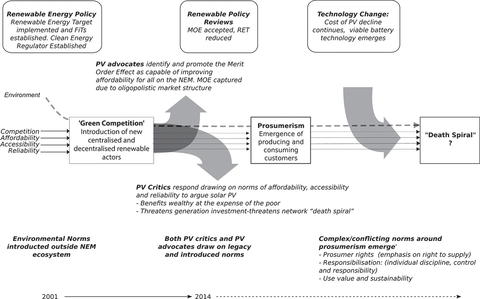Environmental norms and electricity supply: an analysis of normative change and household solar PV in Australia

Abstract: This paper analyses normative change in electricity supply in order to understand the challenges associated with the introduction of a non-negotiable environmental norm, a change necessary to ensure long-term environmental sustainability of the supply system. The analysis combines the work of Wolfgang Streeck together with that of ecological modernisation to trace the fate of an environmental norm as it emerges within a complex pre-existing institutional context comprising social norms around accessibility, affordability and reliability as well as the more recent emphasis on the benefits of competition. The analysis shows how ‘strong’ forms of ecological modernist policy change, policies in which environmental norms were explicit, were vulnerable to carbon intensive businesses arguing that they posed too significant a social risk. Yet, solar PV has been associated with ‘weaker’ forms of ecological modernist policy development where solar proponents have succeeded in demonstrating, despite significant opposition, how solar PV can be embedded within the competition norm thereby promoting both competition and environmental goals. This weaker form of ecological modernist change may have far reaching unintended consequences as solar PV on residential houses enhances the capacity of those households as ‘prosumers’ to ensure their interests are better supported. An environmental norm may be established here but social norms around rights to an essential service may also be placed at risk.
Direct link: http://www.tandfonline.com/doi/full/10.1080/23251042.2016.1155690#.VzQJrBV97WY
| Attachment | Size |
|---|---|
| 792.07 KB |
Web tools and Projects we developed
Open-NEM
The live tracker of the Australian electricity market.
Paris Equity Check
This website is based on a Nature Climate Change study that compares Nationally Determined Contributions with equitable national emissions trajectories in line with the five categories of equity outlined by the IPCC.
liveMAGICC Climate Model
Run one of the most popular reduced-complexity climate carbon cycle models online. Used by IPCC, UNEP GAP reports and numerous scientific publications.
NDC & INDC Factsheets
Check out our analysis of all the post-2020 targets that countries announced under the Paris Agreement.